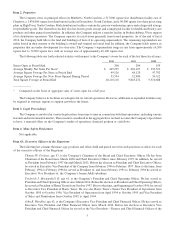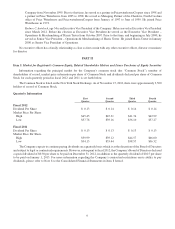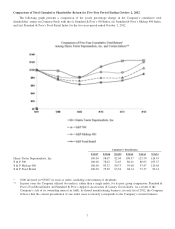Harris Teeter 2012 Annual Report Download - page 19
Download and view the complete annual report
Please find page 19 of the 2012 Harris Teeter annual report below. You can navigate through the pages in the report by either clicking on the pages listed below, or by using the keyword search tool below to find specific information within the annual report._______________
(1) For a more detailed description of the obligations see Notes 7 and 8 to the Consolidated Financial Statements in Item
8 hereof. Amounts represent total expected payments of principal and interest.
(2) Represents the minimum rents payable and includes leases associated with closed stores. The obligations related to the
closed store leases are discussed below. Amounts are not offset by expected sublease income and do not include various
contingent liabilities associated with assigned leases as discussed below.
(3) For a more detailed description of the obligation refer to Note 14 to the Consolidated Financial Statements in Item 8 hereof.
The timing of payment, if any, for the unrecognized tax liability is not certain. However, we believe that we could possibly
be assessed on the tax issues within the next three years.
(4) Represents the projected cash payments associated with certain deferred compensation contracts. The net present value
of these obligations is recorded by the Company and included with other long-term liabilities in the Company’s
consolidated balance sheets.
The table above excludes funding of the Harris Teeter Supermarkets, Inc. Employees’ Pension Plan (the “Pension Plan”),
payments pursuant to the Supplemental Executive Retirement Plan (the “SERP”) and payments pursuant to the Company’s
flexible deferred compensation and survivor benefit plans. The Company’s funding policy in regards to the Pension Plan is to
contribute annually the amount required by regulatory authorities to meet minimum funding requirements and an amount to
increase the funding ratios over future years to a level determined by the Company’s actuaries to be effective in reducing the
volatility of contributions. However, the timing and amount of such contributions or payments may be impacted by a number
of factors, including government regulation, returns on plan assets and actuarial assumptions regarding our future funding
obligations. The Company was not required to make a contribution to the Pension Plan in fiscal 2012; however, the Company
contributed $50 million during fiscal 2012. Payments made pursuant to the SERP, flexible deferred compensation and survivor
benefit plans are not required to be funded in advance, and are equal to the benefit payments made during the year. Actual
payments will be based on various external factors such as retirement dates and mortality. Annual payments pursuant to the
SERP are expected to range between $1.3 million and $2.7 million over the next five years. Benefit payments for the flexible
deferred compensation plan or survivor benefit plan cannot be reasonably estimated due to the various external factors noted above.
For a more detailed description of our pension obligations see Note 15 to the Consolidated Financial Statements in Item 8 hereof.
In connection with the closing of certain store locations, the Company has assigned leases to several sub-tenants with
recourse. These leases expire over the next 9 years, and the future minimum lease payments of approximately $32.9 million,
in the aggregate, over that future period have been assumed by these sub-tenants. In the unlikely event, in management’s opinion
based on the current operations and credit worthiness of the assignees, that all such contingent obligations would be payable
by the Company, the approximate aggregate amounts due by year would be as follows: $8.4 million in fiscal 2013 (25 stores),
$7.4 million in fiscal 2014 (21 stores), $6.1 million in fiscal 2015 (17 stores), $5.0 million in fiscal 2016 (11 stores), $3.6 million
in fiscal 2017 (8 stores) and $2.4 million in aggregate during all remaining years thereafter.
The Company utilizes various standby letters of credit and bonds as required from time to time by certain programs, most
significantly for self-insured programs such as workers compensation and various casualty insurance. These letters of credit
and bonds do not represent additional obligations of the Company since the underlying liabilities are recorded as insurance
reserves and included with other current liabilities on the Company’s consolidated balance sheets. In addition, the Company
occasionally utilizes documentary letters of credit for the purchase of merchandise in the normal course of business. Issued and
outstanding letters of credit totaled $26.2 million as of October 2, 2012.
Off Balance Sheet Arrangements
The Company is not a party to any off-balance sheet arrangements that have, or are reasonably likely to have, a current
or future material effect on the Company’s financial condition, results of operations or cash flows.
Critical Accounting Policies
The preparation of financial statements in conformity with generally accepted accounting principles requires management
to make estimates and assumptions about future events that affect the reported amounts of assets, liabilities, revenues and
expenses and the disclosures of contingent assets and liabilities. Future events and their effects cannot be determined with
absolute certainty. Therefore, management’s determination of estimates and judgments about the carrying values of assets and
liabilities requires the exercise of judgment in the selection and application of assumptions based on various factors including
15
























